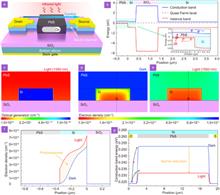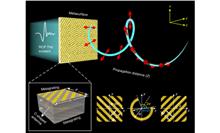 View fulltext
View fulltext
The integration between infrared detection and modern microelectronics offers unique opportunities for compact and high-resolution infrared imaging. However, silicon, the cornerstone of modern microelectronics, can only detect light within a limited wavelength range (< 1100 nm) due to its bandgap of 1.12 eV, which restricts its utility in the infrared detection realm. Herein, a photo-driven fin field-effect transistor is presented, which breaks the spectral response constraint of conventional silicon detectors while achieving sensitive infrared detection. This device comprises a fin-shaped silicon channel for charge transport and a lead sulfide film for infrared light harvesting. The lead sulfide film wraps the silicon channel to form a “three-dimensional” infrared-sensitive gate, enabling the photovoltage generated at the lead sulfide-silicon junction to effectively modulate the channel conductance. At room temperature, this device realizes a broadband photodetection from visible (635 nm) to short-wave infrared regions (2700 nm), surpassing the working range of the regular indium gallium arsenide and germanium detectors. Furthermore, it exhibits low equivalent noise powers of 3.2×10?12 W·Hz?1/2 and 2.3×10?11 W·Hz?1/2 under 1550 nm and 2700 nm illumination, respectively. These results highlight the significant potential of photo-driven fin field-effect transistors in advancing uncooled silicon-based infrared detection.
Conventionally, the spatially structured light beams produced by metasurfaces primarily highlight the polarization modulation of the beams propagating along the optical axis or the beams' spatial transmission trajectory. In particular, along the optical axis, the polarization state is either constant or varies continuously in each output plane. Here, we develop innovative spatially structured light beams with continually changing polarization along any arbitrary spatial transmission trajectories. With tri-layer metallic metasurfaces, the geometric characteristics of each layer structure can be adjusted to modulate the phase and polarization state of the incident terahertz (THz) wave. The beam will converge to the predefined trajectory along several paths to generate a Bessel-like beam with longitudinal polarization changes. We demonstrate the versatility of the approach by designing two THz-band structured light beams with varying polarization states along the spatial helical transmission trajectory. Continuous linear polarization changes and linear polarization to right circular polarization (RCP) and back to linear polarization changes are realized respectively. The experimental results are basically consistent with the simulated results. Our proposal for arbitrary trajectory structured light beams with longitudinally varying polarization offers a practical method for continuously regulating the characteristics of spatial structured light beams with non-axial transmission. This technique has potential uses in optical encryption, particle manipulation, and biomedical imaging.










